12 Trending Wall Painting Styles You Need to Know in 2025
As we navigate 2025, our homes continue to be our most personal sanctuaries, evolving spaces that reflect our desire for comfort, self-expression, and connection. One of the most dynamic and accessible ways to breathe fresh life into any room is through the transformative power of paint. This year, wall painting styles are moving beyond mere color application, embracing textures, patterns, and immersive experiences that speak to broader design movements. If you’re looking to update your interiors and create a space that feels both current and deeply personal, understanding these trending styles is your first step.
Forget fleeting fads; the wall painting trends of 2025 are about creating environments that resonate, from a renewed appreciation for nature’s palette to bold, artistic statements and a sophisticated take on minimalism. Whether you’re a DIY enthusiast ready for your next project or planning a professional refresh, these 12 stunning wall painting styles will provide ample inspiration to turn your walls into captivating focal points that are undeniably “now.”
Why Embrace Trending Wall Painting Styles in 2025?
Updating your walls with current trends isn’t just about keeping up with the Joneses; it’s about:
- Modernizing Your Space: Trending styles can instantly make your home feel more contemporary and thoughtfully designed.
- Enhancing Ambiance: Current trends often reflect a collective desire for certain moods – be it tranquility, warmth, or joyful expression.
- Boosting Personal Connection: Aligning your home with styles you love creates a more harmonious and enjoyable living environment.
- Increasing Appeal: If you’re considering selling in the near future, updated and stylish interiors can significantly enhance your home’s marketability.
- Inspiring Creativity: Exploring new styles can be a fantastic catalyst for your own creative expression within your home.
Let’s dive into the wall painting styles that are defining interiors in 2025.
12 Trending Wall Painting Styles Defining 2025
1. Biophilic Murals & Nature-Inspired Hues: The Great Indoors
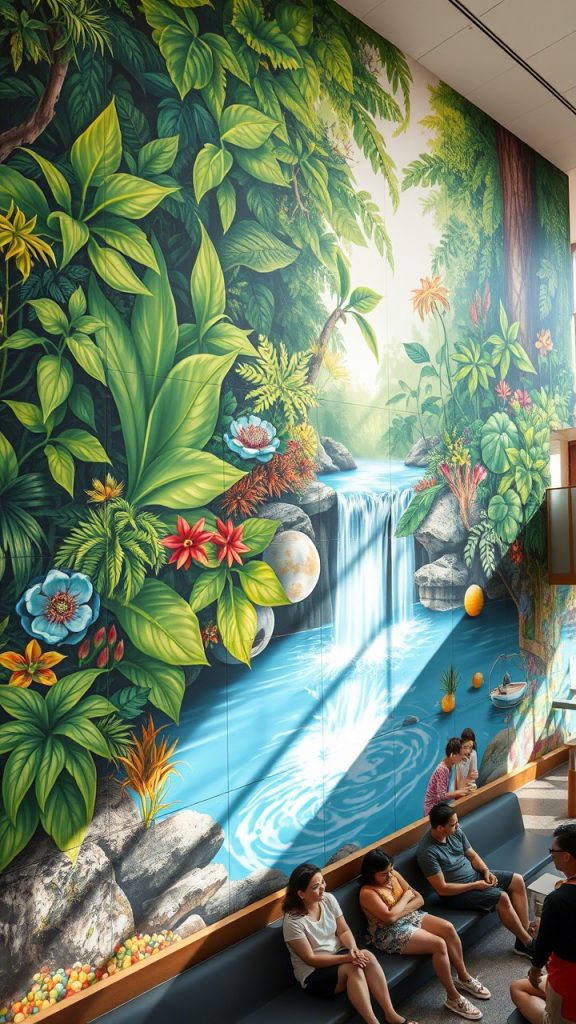
- The Style: This trend brings the calming and restorative elements of the outdoors in. Think accent walls adorned with hand-painted or stenciled botanical murals (leafy patterns, subtle florals, forest silhouettes) or entire rooms enveloped in earthy greens, sky blues, warm browns, and terracotta. It’s less about photorealism and more about evoking the feeling of nature.
- Why It’s Trending in 2025: The focus on wellness, sustainability, and a deeper connection with the natural world continues to grow. Biophilic design elements in paint reduce stress and create a serene, grounding atmosphere in our increasingly digital lives.
- How to Achieve the Look:
- Colors: Olive green, sage, moss, deep forest green, sky blue, cerulean, warm clay, terracotta, sandy beige, rich chocolate brown.
- Techniques: Consider a single accent wall with a large-scale leaf stencil or a simplified mountain range. For an all-over feel, choose a nature-inspired solid color. Freehand painting of abstract botanical shapes or subtle branch motifs can add an artisanal touch.
- Best Rooms/Applications: Bedrooms for a tranquil retreat, living rooms to create a calming social space, home offices to reduce stress, bathrooms for a spa-like feel.
2. Tactile Textured Finishes: Engaging the Senses
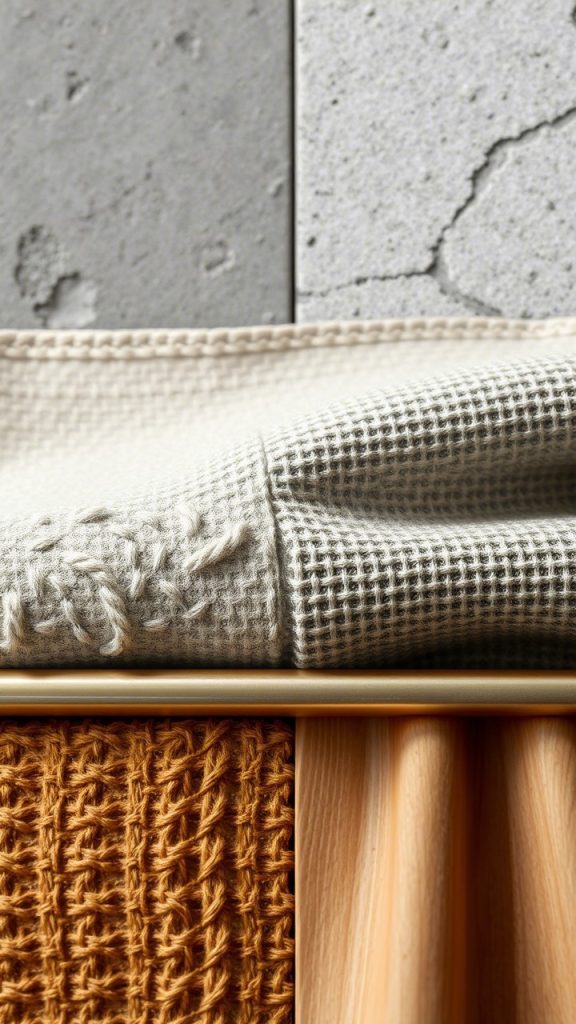
- The Style: Flat, smooth walls are taking a backseat to surfaces that invite touch and create visual depth. Limewash, Roman clay, plaster-look finishes, and subtle suede or concrete effects are highly sought after. These finishes are often characterized by their soft, matte appearance and organic, slightly imperfect variations in tone and texture.
- Why It’s Trending in 2025: There’s a growing desire for warmth, authenticity, and artisanal character in interiors. Textured finishes add a layer of sophistication and a handcrafted feel, moving away from mass-produced uniformity. They also tie into the “quiet luxury” and “cozy minimalism” aesthetics.
- How to Achieve the Look:
- Materials: Specialty paints like limewash (which creates a chalky, matte, subtly varied surface) or Roman clay (for a smooth, mottled, marble-like appearance). Joint compound can also be used with specific techniques (like skip troweling) to create plaster-like effects before painting.
- Techniques: Application often involves specialized brushes or trowels, creating soft, cloudy, or subtly striated patterns. Many brands offer DIY-friendly versions of these traditional finishes.
- Best Rooms/Applications: Living rooms for a sophisticated backdrop, dining rooms for an earthy elegance, bedrooms for a cocooning feel, hallways and entryways to make a textural first impression.
3. Immersive Color Drenching: The Monochromatic Embrace
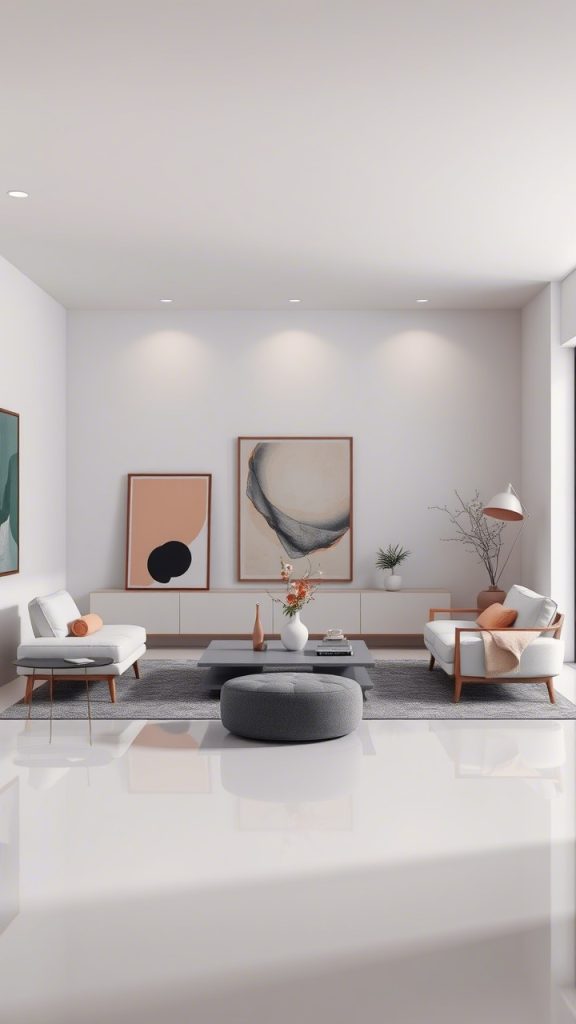
- The Style: This bold technique involves painting the walls, trim (baseboards, window and door frames), doors, and even the ceiling in the same color, or very closely related shades of that color.
- Why It’s Trending in 2025: Color drenching creates a cohesive, enveloping, and incredibly chic look. It can make a room feel larger by blurring the lines between surfaces, or intensely cozy and dramatic when using deeper hues. It’s a modern statement that feels both luxurious and contemporary.
- How to Achieve the Look:
- Colors: Works beautifully with rich jewel tones (emerald, sapphire, deep ruby), moody hues (charcoal, deep teal, forest green), and also surprisingly well with warm, earthy neutrals or even soft, muted pastels for a gentler take.
- Techniques: The key is consistency in color. Varying the sheen can add subtle interest – for example, matte or eggshell on walls, and a satin or semi-gloss on trim and doors in the exact same color.
- Best Rooms/Applications: Bedrooms for a cocooning retreat, living rooms for a sophisticated statement, dining rooms for dramatic flair, home offices for a focused environment, or even smaller powder rooms to create a jewel-box effect.
4. Evolved Arches & Organic Shapes: Softening the Edges

- The Style: The popularity of painted arches continues, but in 2025, it’s evolving with more organic, free-flowing shapes, soft curves, and asymmetrical designs. Think elongated arches, “pond” or “pebble” shapes, or gentle waves of color used to define zones, frame furniture, or create artistic focal points.
- Why It’s Trending in 2025: These softer geometries move away from rigid lines, reflecting a desire for more fluid, comforting, and playful interior spaces. They add an element of bespoke artistry and architectural interest without actual construction.
- How to Achieve the Look:
- Colors: Contrasting colors make the shape pop, while a slightly darker or lighter shade of the main wall color offers a more subtle, integrated look. Earthy tones and muted pastels are popular choices for these shapes.
- Techniques: Use the string-and-pencil method for perfect arches. For more organic shapes, lightly sketch your design freehand first. Use high-quality painter’s tape for any straight sections and flexible painter’s tape or careful brushwork for curves.
- Best Rooms/Applications: Behind headboards in bedrooms, framing desks or reading nooks in home offices or living rooms, children’s rooms for a playful touch, or in entryways to create a unique welcome.
5. Warm Neutrals & Rich Earth Tones: The Comfort Palette
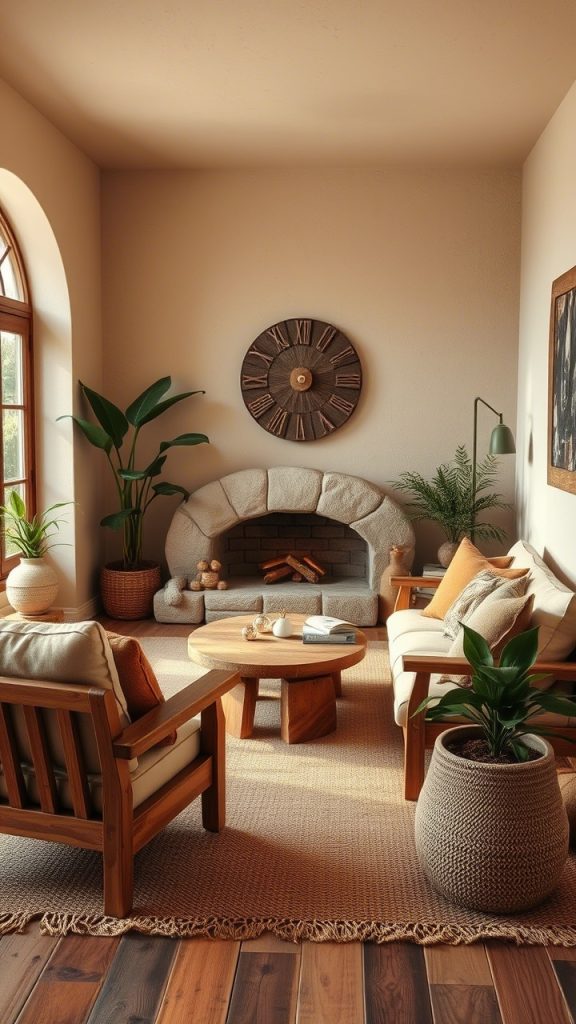
- The Style: Cool grays are definitively making way for warmer, more inviting neutrals. Think creamy off-whites, soft beiges, warm taupes, mushroom browns, and rich caramel or terracotta hues. These colors often have complex undertones that add depth and sophistication.
- Why It’s Trending in 2025: There’s a collective yearning for comfort, coziness, and spaces that feel grounding and nurturing. Warm neutrals and earth tones provide this sense of stability and connection to the natural world, creating an inviting and timeless backdrop.
- How to Achieve the Look:
- Colors: Focus on shades with warm undertones – terracotta, ochre, sienna, camel, warm greige, and complex browns like “Mocha Mousse” (Pantone’s 2025 Color of the Year pick) or Benjamin Moore’s “Cinnamon Slate.”
- Techniques: These colors work beautifully as all-over wall colors. Pair them with natural materials like wood, linen, and stone. Consider a matte or eggshell finish to enhance their soft, earthy quality.
- Best Rooms/Applications: Living rooms for a cozy and inviting atmosphere, bedrooms for a restful sanctuary, dining rooms for a warm gathering space, home offices to create a focused yet comfortable environment.
6. Moody & Atmospheric Hues: Embracing Depth and Drama
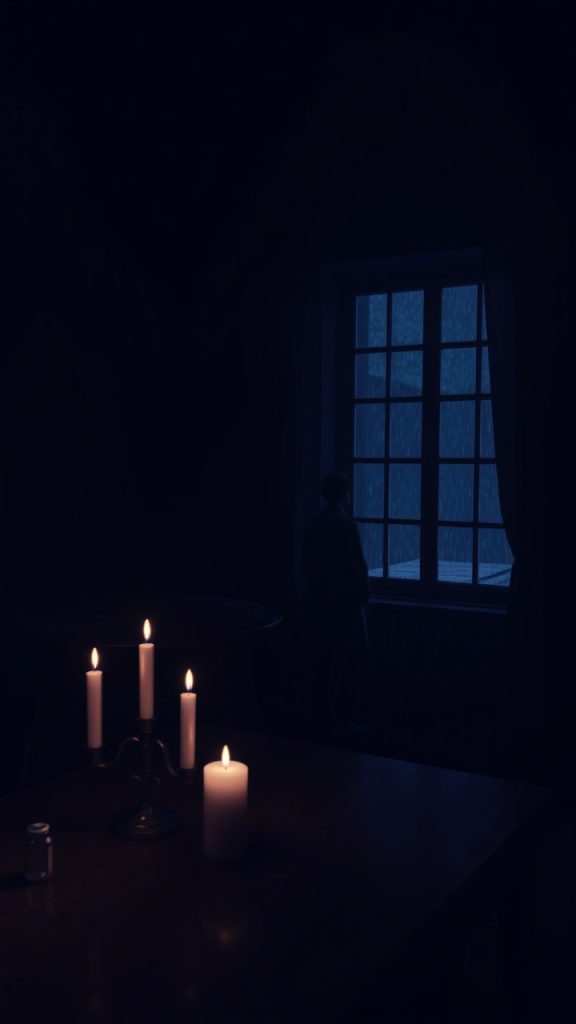
- The Style: A departure from all-light-and-airy, this trend embraces deep, saturated, and moody colors that create a sense of drama, intimacy, and sophistication. Think deep jewel tones, inky blues, forest greens, rich burgundies, andcharcoals.
- Why It’s Trending in 2025: As a counterpoint to minimalism, there’s a growing confidence in using bold color to create immersive and emotionally resonant spaces. These colors can make a room feel like a cozy, protective haven or a luxurious, enveloping retreat.
- How to Achieve the Look:
- Colors: Emerald green, sapphire blue, amethyst purple, deep ruby or burgundy, Farrow & Ball’s “Brinjal” (a deep aubergine), rich mahogany, or dark olive.
- Techniques: Often used in color drenching (Style #3) or as impactful accent walls. Matte finishes enhance the velvety depth of these colors. Balance with good lighting (both natural and artificial) and lighter or metallic accents in decor to prevent the space from feeling too heavy.
- Best Rooms/Applications: Dining rooms for a dramatic entertaining space, bedrooms for a cocooning and intimate feel, home offices or libraries for a sense of focus and sophistication, powder rooms for a jewel-box effect.
7. Sophisticated Color Blocking: Refined & Intentional
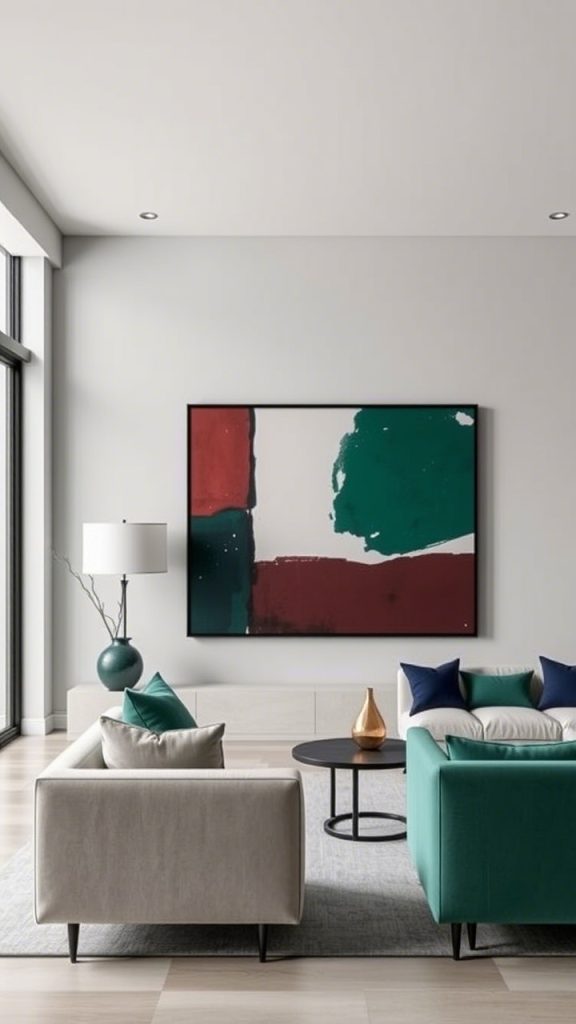
- The Style: Color blocking moves beyond playful primary colors into more refined and strategic applications. This involves using fewer, larger blocks of carefully chosen complementary or analogous colors to define architectural spaces, create focal points, or add a graphic, art-like quality to walls. The lines are crisp, and the color choices are often more muted or sophisticated.
- Why It’s Trending in 2025: It’s a way to introduce multiple colors and create visual interest without the busyness of small patterns. It feels modern, intentional, and can cleverly manipulate the perception of a room’s proportions.
- How to Achieve the Look:
- Colors: Think pairings like a warm neutral with a muted jewel tone, or two analogous earthy shades. The key is a harmonious or purposefully contrasting palette that feels curated.
- Techniques: Meticulous planning and taping are essential for sharp, clean lines. Consider how the blocks will interact with furniture, artwork, and sightlines. Shapes might extend across corners or onto ceilings for added impact.
- Best Rooms/Applications: Living rooms to define seating or media zones, home offices to delineate work areas, dining rooms for a modern graphic statement, or even hallways to create visual flow.
8. Delicate Micro-Patterns & Subtle Stenciling: The New Detail
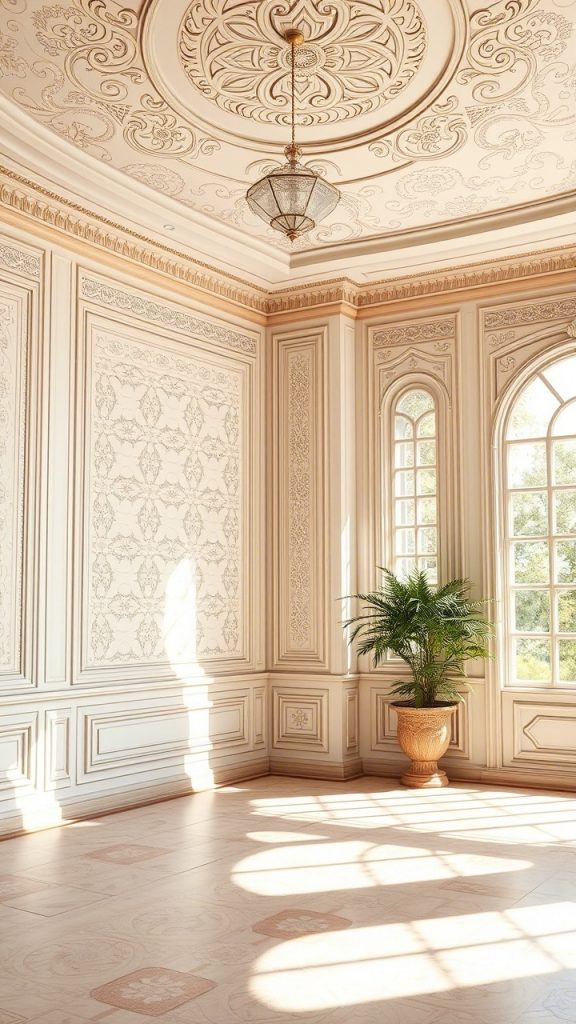
- The Style: Instead of large, bold patterns, this trend focuses on small-scale, delicate patterns often applied with stencils or very fine brushwork. Think tiny repeating botanicals, subtle geometric motifs, or almost-invisible linear designs that add a layer of texture and interest upon closer inspection.
- Why It’s Trending in 2025: It’s a nod to craftsmanship and detail without being overwhelming. This style aligns with “quiet luxury” and a desire for personalized, unique touches that aren’t immediately obvious but add depth and character to a space.
- Best For: Bedroom accent walls for a touch of romance or intricacy, powder rooms for an all-over delicate pattern, the back of bookshelves, or as a subtle border detail.
- How to Achieve the Look:
- Tools: Fine-tipped paint pens, small artist’s brushes, or intricate stencils.
- Techniques: Apply with a light touch. For stencils, use a stencil brush or dense foam roller with minimal paint to prevent bleeding. Tone-on-tone applications (e.g., a slightly glossier version of the wall color) can be particularly effective for subtlety.
- Best Rooms/Applications: Bedrooms for a touch of refined elegance, powder rooms, dressing areas, or any space where a subtle, detailed finish is appreciated.
9. Artisanal & Hand-Finished Effects: Celebrating Imperfection
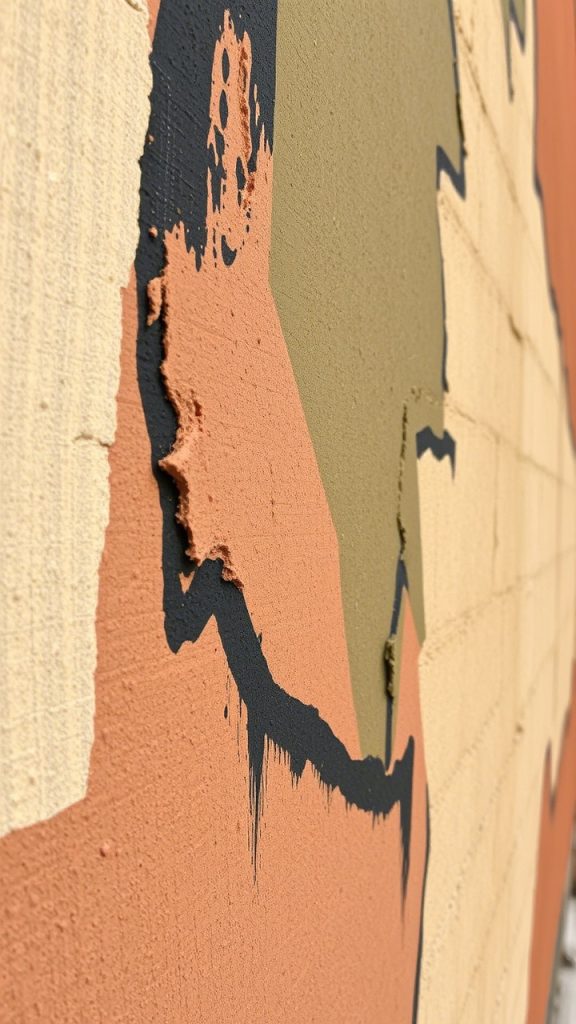
- The Style: This trend embraces the beauty of handcrafted finishes, where slight imperfections and variations are part of the charm. This includes techniques like uneven color washes, subtly imperfect stripes, hand-brushed textures, or finishes that mimic aged plaster or hand-troweled effects.
- Why It’s Trending in 2025: There’s a strong movement away from a “too perfect,” mass-produced look towards unique, characterful spaces that feel authentic and lived-in. Artisanal finishes tell a story and showcase a human touch.
- How to Achieve the Look:
- Techniques: Color washing (applying a thinned glaze over a base coat), ragging, sponging (used in a contemporary, subtle way), or intentionally imperfect brushstrokes. The key is a relaxed, less rigid application.
- Colors: Earthy tones, muted colors, and natural pigments often lend themselves well to this style.
- Best Rooms/Applications: Living rooms with a rustic or bohemian vibe, dining rooms for an old-world charm, bedrooms for a soft, organic feel, or hallways to add character.
10. High-Gloss Accents & Ceilings: Reflective Radiance
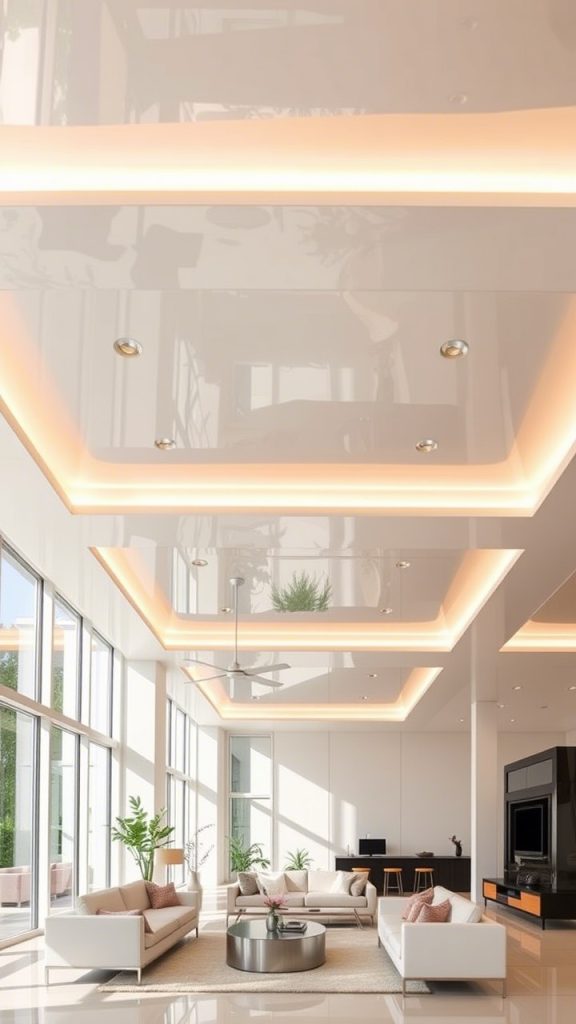
- The Style: While matte finishes dominate walls, 2025 sees a strategic and sophisticated use of high-gloss paint as an accent. This is particularly impactful on ceilings (“lacquered look”), trim, interior doors, or even a single, perfectly smooth accent wall in a bold color.
- Why It’s Trending in 2025: High-gloss finishes add an unexpected touch of glamour, reflect light beautifully (making spaces feel brighter and sometimes larger), and create a striking contrast with surrounding matte surfaces. A high-gloss ceiling, in particular, is a designer trick for adding drama and an illusion of height.
- How to Achieve the Look:
- Preparation is Paramount: High-gloss paint highlights every imperfection. The surface must be perfectly smooth (Level 5 drywall finish is ideal).
- Application: Apply multiple thin, even coats, often with a fine-finish roller or by spraying for the best results.
- Colors: Deep, rich colors look incredibly luxurious in high gloss. Even white or a pale pastel can create a stunning lacquered effect on a ceiling.
- Best Rooms/Applications: Dining room ceilings for drama, powder rooms for a jewel-box feel, libraries or home offices for a sophisticated accent, or on architectural details like trim and doors.
11. Retro Revival Hues & Graphics: Nostalgia Reimagined
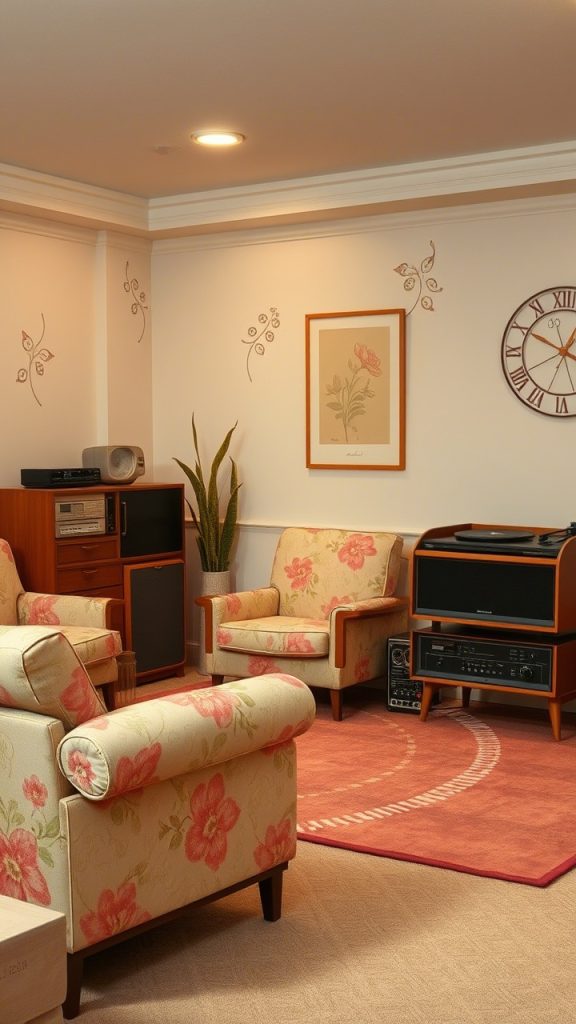
- The Style: Drawing inspiration from the 70s, 80s, and even early 90s, this trend sees a comeback of specific color palettes and graphic elements, but with a modern twist. Think warm, earthy tones of the 70s (mustard yellow, avocado, burnt orange), bold color blocking reminiscent of the 80s, or even softer, more playful pastels from the 90s.
- Why It’s Trending in 2025: Nostalgia continues to be a strong influence in design, offering a sense of comfort and familiarity. These retro elements are being reinterpreted in fresh, contemporary ways.
- How to Achieve the Look:
- Colors: Research color palettes from your chosen era. For a 70s vibe, think rust, olive, mustard, and brown. For an 80s feel, consider bold primaries or pastels with graphic black accents.
- Techniques: Color blocking, bold stripes, or even simple geometric motifs common in those decades. The key is to balance the retro elements with modern furnishings for a curated, not costume-y, look.
- Best Rooms/Applications: Living rooms for a conversation-starting feature, kitchens with retro-inspired cabinetry colors, home offices for a fun, energetic vibe, or basements and entertainment areas.
12. “Quietly Colorful” Hues & Diffused Palettes: The New Neutrals
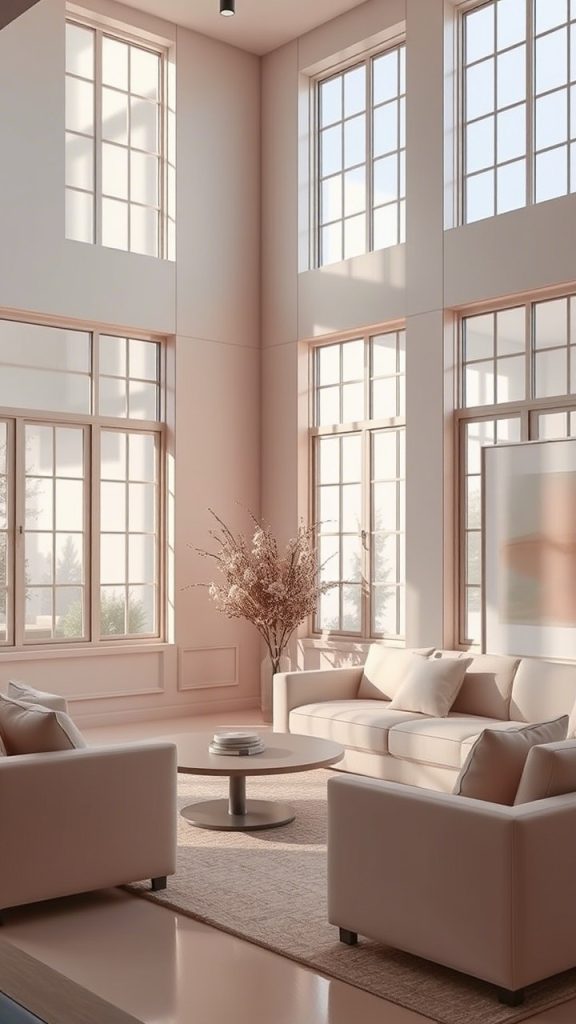
- The Style: Moving beyond stark whites and cool grays, this trend embraces colors that are “quietly colorful”—diffused, mellow shades that have depth and character but still function as sophisticated neutrals. Think dusty blues, muted greens (like sage or eucalyptus), complex “muddy” pinks or mauves, and soft, earthy browns with interesting undertones.
- Why It’s Trending in 2025: There’s a desire for spaces that feel calm, harmonious, and subtly personalized without shouting for attention. These nuanced colors provide a soothing backdrop that complements a wide range of decor styles and materials. They offer more personality than traditional neutrals while maintaining a sense of tranquility.
- How to Achieve the Look:
- Colors: Look for colors that are desaturated or have a touch of gray or brown in them. Examples include Sherwin-Williams’ “Carnelian,” Benjamin Moore’s “Leather Saddle Brown,” or Behr’s “Colorful Leaves.”
- Techniques: These colors are perfect for all-over wall applications, creating an immersive and serene environment. They pair beautifully with natural textures and warm metals. A matte or eggshell finish enhances their soft, sophisticated appeal.
- Best Rooms/Applications: Bedrooms for a restful and nurturing atmosphere, living rooms for a calm yet characterful backdrop, home offices for a focused and serene workspace, or entire homes for a cohesive, subtly colorful flow.
Frequently Asked Questions
- Q: What are the most dominant color palettes trending for walls in 2025?
A: Warm, earthy neutrals (terracotta, beige, mushroom brown, Mocha Mousse), nature-inspired greens and blues (olive, sage, sky blue), moody jewel tones (emerald, sapphire, deep ruby/burgundy), and “quietly colorful” hues (dusty pinks, muted mauves, complex desaturated colors) are very prominent. - Q: Are accent walls still in style for 2025?
A: Yes, accent walls are definitely still in style, but they are often executed with more intention. Think textured finishes, biophilic murals, sophisticated color blocking, or a wall featuring a high-gloss sheen or a bold, moody color as part of a larger design concept. - Q: What’s the best way to incorporate texture into my wall paint in 2025?
A: Limewash, Roman clay, or paints that mimic suede or plaster are very on-trend. These offer a tactile and visually deep finish. You can apply these to all walls for an immersive feel or to an accent wall for a strong focal point. DIY-friendly versions are increasingly available. - Q: How can I try a “moody” color trend without making my room feel too dark or small?
A: Start with an accent wall. Ensure the room has ample natural and artificial light. Balance the dark wall color with lighter furnishings, rugs, and metallic or reflective decor accents. A matte finish on the dark color can also make it feel softer and more velvety rather than heavy. - Q: Is DIY-ing these trending paint styles difficult for a beginner?
A: Some trends are very beginner-friendly (e.g., warm neutral all-over color, a simple accent wall, basic color blocking with good tape). Others, like flawless high-gloss finishes or complex murals, may require more skill or patience. Textured finishes like limewash have a learning curve but many DIYers achieve great results by following tutorials. - Q: How important is sustainability in 2025 paint trends?
A: Very important. While not a “style” itself, the choice of low-VOC (Volatile Organic Compounds) or zero-VOC paints, as well as paints from companies with sustainable practices, is a significant underlying trend that informs material choices across all styles. - Q: Are there any specific paint techniques that are particularly popular for achieving these 2025 looks?A: Techniques for applying textured finishes (limewash brushing, troweling for Roman clay), precise taping for color blocking and geometric accents, blending for subtle ombre effects, and careful application for high-gloss sheens are all relevant.
- Q: How can I make sure a trending style will suit my existing furniture and decor?
A: Choose trends that complement your core furniture style. For instance, earthy textures and biophilic colors work well with rustic, bohemian, or Scandinavian furniture. Moody hues and high-gloss accents can suit modern or art-deco pieces. Always test large paint swatches in your room with your existing items before committing. - Q: What’s the best way to test out a bold trending color before painting an entire wall or room?
A: Paint a large poster board or a sizable section of drywall (at least 2×2 feet) with two coats of your chosen color. Move this sample around the room at different times of day to see how it looks in various lighting conditions and against your furniture. - Q: Are there any “classic” styles that are being reinterpreted in 2025?A: Yes, color blocking is being done with more sophisticated palettes. Accent walls are more about texture or murals than just a single different color. Even stripes are seeing more artisanal, hand-painted interpretations or subtle tone-on-tone applications.
- Q: With the rise of digital and AI, are there any tech-influenced paint trends emerging in 2025?
A: While more niche, there’s an emerging interest in AI-generated patterns for custom stencils or mural inspiration, leading to unique abstract or futuristic designs. However, the dominant trends still lean towards natural, tactile, and comforting aesthetics, sometimes as a counterbalance to our tech-saturated lives.
Conclusion – Paint Your Way to a Stylish 2025
The wall painting trends of 2025 offer a rich tapestry of styles, from the grounding embrace of nature to the sophisticated allure of textured finishes and the bold statements of color drenching. What unites them is a desire for spaces that are not only aesthetically pleasing but also deeply personal, comfortable, and reflective of our evolving lifestyles.
Whether you’re drawn to the calming influence of biophilic design, the artisanal charm of hand-finished effects, or the chic drama of moody hues, there’s a trending style ready to transform your walls. Don’t be afraid to experiment, to combine elements, or to put your own unique spin on these inspiring ideas. After all, the most stunning wall is one that truly resonates with you and turns your house into a home that feels perfectly 2025.


Leave a Reply